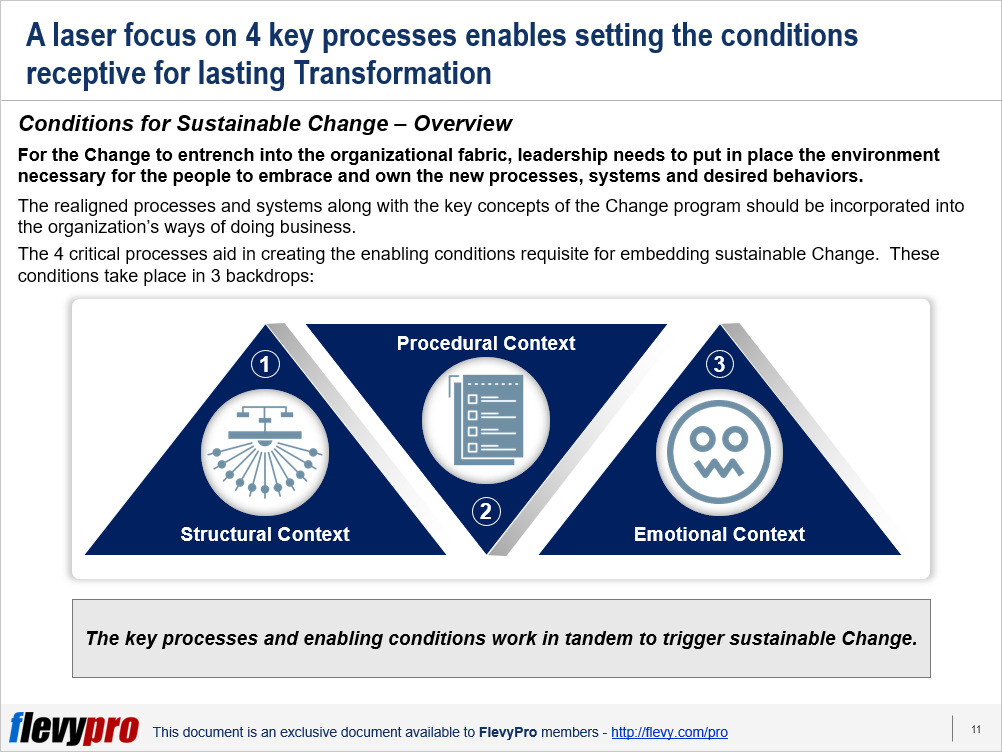3 Conditions for Sustainable Change
4 Sep


With most Transformation initiatives people gradually revert back to their old habits of doing things. Sustainable Change Management necessitates 4 key processes:
- Chartering—defining the scope, rationale, and team for the change initiative.
- Learning—testing and refining ideas before a full-blown execution of the initiative.
- Mobilizing—using symbols and metaphors to engage people and gain their buy-in for the change program.
- Realigning—redefining the roles and responsibilities and managing performance of the initiative and the people driving it.
These processes are critical to enable an Organizational Culture which encourages execution of lasting change.
In addition to these key processes, for the change to entrench into the organizational fabric, Leadership needs to put in place the environment necessary for the people to embrace and own the new processes, systems, and desired behaviors.
The 4 critical processes aid in creating the enabling conditions necessary for institutionalizing change in the organization. These enabling conditions for sustainable Change take place in 3 settings:
- Structural Context
- Procedural Context
- Emotional Context

The environment for sustainable change must be put in place way before the actual execution of the Transformation initiative. These enabling conditions encompass making changes to the organization’s structure, procedures, and sentiments / behaviors.
Let’s dive deeper into the 3 conditions critical to enable sustainable change in the institution.
Structural Context
The first element of the enabling environment requires the change leadership to work on reshaping the organizational structure. The 4 key processes have a direct bearing on the organization’s structure. Their effect pervades over:
- The organization’s hierarchy and reporting lines.
- Compensations, benefits, and rewards systems.
- Monitoring and control systems.
The Structural Context significantly affects the way employees’ work and expend their time and their interest in certain types of projects.
The structural context is altered during the Realigning process of Transformation in the way new personnel practices are employed. The Learning process informs the redefinition of linkage between the leadership and field staff. The Mobilizing process informs the changes to be made in the roles and responsibilities of the management and front-line people—through storytelling and metaphors. Whereas, the Chartering process helps instill a reformed, team-building culture in the organization. Together, these changes in the structural context cascade down across the organization.
Procedural Context
The Procedural context pertains to a feeling of objectivity and authenticity of new processes and systems. The Procedural environment involves the perception of people that their views are taken seriously and acted upon while designing and implementing a new initiative.
Procedural authenticity is critical in gaining commitment from the employees on initiatives that were not validated by them earlier. It involves belief of the people that the change initiative integrates well with the philosophies of the organization and the way business should be done. It makes the people feel heard, ensures trustworthiness of the change leadership through positive track records and effective decision making abilities, and alignment of the change initiative with the core values of the organization.
Interested in learning more about the other enabling conditions mandatory for institutionalizing change? You can download an editable PowerPoint on Conditions for Sustainable Change here on the Flevy documents marketplace.
Did You Find Value in This Framework?
You can download in-depth presentations on this and hundreds of similar business frameworks from the FlevyPro Library. FlevyPro is trusted and utilized by 1000s of management consultants and corporate executives. Here’s what some have to say:
“My FlevyPro subscription provides me with the most popular frameworks and decks in demand in today’s market. They not only augment my existing consulting and coaching offerings and delivery, but also keep me abreast of the latest trends, inspire new products and service offerings for my practice, and educate me in a fraction of the time and money of other solutions. I strongly recommend FlevyPro to any consultant serious about success.”
– Bill Branson, Founder at Strategic Business Architects
“As a niche strategic consulting firm, Flevy and FlevyPro frameworks and documents are an on-going reference to help us structure our findings and recommendations to our clients as well as improve their clarity, strength, and visual power. For us, it is an invaluable resource to increase our impact and value.”
– David Coloma, Consulting Area Manager at Cynertia Consulting
“FlevyPro has been a brilliant resource for me, as an independent growth consultant, to access a vast knowledge bank of presentations to support my work with clients. In terms of RoI, the value I received from the very first presentation I downloaded paid for my subscription many times over! The quality of the decks available allows me to punch way above my weight – it’s like having the resources of a Big 4 consultancy at your fingertips at a microscopic fraction of the overhead.”
– Roderick Cameron, Founding Partner at SGFE Ltd
























